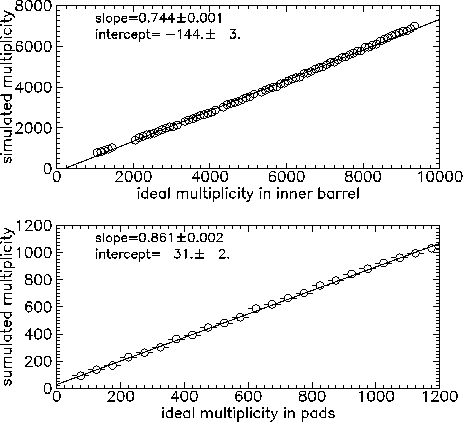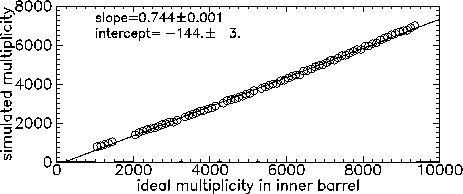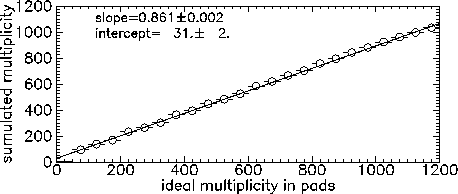






|

|

The following are less complex versions of the plots shown in the others parts of this note -- intended for use as figures and text in a paper for the IEEE conference.
First, here is a summary of the discriminator performance information (also available in postscript ):

For a set of simulated events in the PHENIX detector, these two dimensional plots show the multiplicity which would be detected with a perfect discriminator set at 0.25 mip (ideal multiplicity) vs. the mean multiplicity which would be detected using discriminators with the performance described in this paper (simulated multiplicity). The slope of the fitted line gives the average efficiency of the discriminators -- which is less than one because the threshold for most channels are above the ieal value of 1/4 mip. Nevertheless, the linear relationship between the two means that a trigger based on these discriminators should work in this range of multiplicity values. The range of multiplicity values is goes up to the maximum values expected for Au+Au collisions at RHIC.
The top plot summarizes the discriminator's performance in a trigger based on the MVD strip detectors in the inner barrel. The average efficiency is about 74%. The relationship between the ideal and simulated multiplicities is not perfectly linear. The small departure from linear behavior seen at high multiplicities is a result of double hits in the strips. When the multiplicity is very high, some strips have more than one particle hitting them. The resulting signal is therefore larger and the discriminators appear to be more efficient.
The bottom plot summarizes the discriminator's performance in a trigger based on the MVD pad detectors. The average efficiency is about 86%. This is higher than the efficiency seen for strip detectors due to the different geometry of the two types of detectors. The incident angle of most particles hitting the MVD pads is almost perpendicular to the surface. The observed signal is therefore the result of a particle passing through about 300 microns of Si -- this is our definition of a "1 mip" signal. Most particles which hit the MVD strips enter the Si close to parallel to the surface of the Si. The strip pitch is 200 microns. The observed signal in the strips is therefore the result of a particle passing through 200 microns of Si (about 2/3 of a mip). The apparent discriminator efficiency is therefore higher for pads than for strips. The relationship between the ideal and simulated multiplicities is closer to linear for the pads than for strips. This is because the probability of a two particles hitting a single pad is less than the double-hit probability for strips -- it is the double hits in the strips which causes the departure from linear behavior.
The following plot shows the results for the MVD barrel only (also available in postscript ):

The following plot shows the results for the MVD pad detectors only (also available in postscript ):


John Sullivan
sullivan@lanl.gov
updated Thursday December 18, 1997